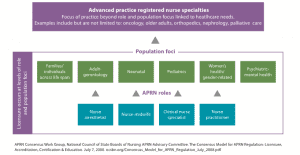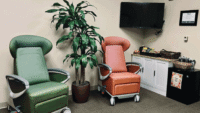Takeaways:
- Choosing the right NP specialty can be difficult decision for the RN ready to move forward with education and career goals.
- Knowing educational options for selecting the right degree and the right type of program when choosing to become a NP can help the RN make the appropriate decision.
Have you decided you’re ready to pursue becoming a nurse practitioner (NP)? If so, take some time to discuss your career goals and pursuit of graduate education with family members who will be most affected by this decision. You’ll want (and need) their support. Next, identify the patient population you’re most passionate about and the settings in which you prefer to practice. After that, choose the educational track that will help you meet your goals, find a program that accommodates your individual learning needs, and select the appropriate certification and licensure. Use this article as a guide to help you carve your NP educational path.
What’s your preferred patient population and setting?
NP patient population options include family (across the life span), adult-gerontology (acute or primary care), pediatric (acute or primary care), neonatal, women’s health, and psychiatric/mental health. One of the most important decisions you’ll make as a prospective NP student is deciding which patient population you’ll pursue and what setting you prefer. Do you want to care for adults with chronic but stable conditions in a clinic or home setting? Or do you see yourself caring for patients with acute or critical conditions in a hospital setting?
Commonalities and overlap of NP education exist. For example, all NPs receive graduate-level education (either a master’s or doctoral degree) and licensure is attained in the state where you’ll practice. Scope of practice, which is regulated by state boards of nursing, varies between states and continues to evolve, and hospitals govern institutional privileging related to practice parameters.
Nurse practitioners (NPs) can follow various educational paths to achieve their career goals. The following table provides an overview of each specialty and links to websites for more information.
| Specialty
| Certifying organization | Patient age ranges | Scope of practice | Places of employment | Website for more information |
| AG–ACNP | ANCC AACN | 13 years to geriatric | You’ll care for patients who: ·are acutely, critically, or chronically ill ·are physiologically unstable ·require technology resources such as ventilators, monitors, and telehealth · are vulnerable to complications | ·Hospital (in ICU or as a hospitalist) ·subspecialties (e.g., cardiology, pulmonology, nephrology) ·inpatient and outpatient areas with focus on patients with acute care issues or acute exacerbation of a chronic illness | ·nursingworld.org /ancc |
| AG–PCNP | ANCC AANP | 13 years to geriatric | You’ll care for patients who: ·are well ·have chronic illnesses | Community-based settings such as: ·primary care ·subspecialties | ·nursingworld.org /ancc |
| FNP | ANCC AANP | All ages | You’ll care for patients who: ·are medically stable ·have episodic acute illness | Community-based setings, such as: ·clinics ·schools ·subspecialties | ·nursingworld.org /ancc |
| ACPNP | ANCC AACN NCC PNCB | Birth to 21 years
| You’ll care for patients who: ·have complex conditions ·have rapidly changing clinical conditions | Pediatric settings such as: ·hospitals (in ICU or as hospitalist) ·urgent care ·subspecialties | ·nursingworld.org /ancc |
| PNP | PNCB | Birth to 21 years
| You’ll care for patients who: ·are well · have chronic illnesses. | Community-based pediatric settings, such as: ·clinics ·schools ·subspecialties | ·nccwebsite.org
|
| NNP | NANNP | 0-2 years | You’ll care for patients who are: ·preterm ·full term | Inpatient and outpatient settings, such as: ·neonatal ICU ·private practice | ·nann.org/ membership/ nannp |
| WHNP | NCC
| Women of all ages | You’ll provide: ·primary care ·reproductive care | Outpatient settings, such as: ·private practice ·clinics | ·nbcc.org/ Certification/ NCC |
| PMHNP | ANCC
| All ages | You’ll provide mental health: ·evaluation ·treatment | Inpatient and outpatient settings, such as: ·primary care ·hospitals | ·nursingworld.org /ancc |
AACN = American Association of Critical-Care Nurses, AANP = American Association of Nurse Practitioners, ACPNP = acute care pediatric nurse practitioner, AG-ACNP = adult–gerontology acute care nurse practitioner, AG–PCNP = adult–gerontology primary care nurse practitioner, ANCC = American Nurses Credentialing Center, FNP = family nurse practitioner, PMHNP = psychiatric mental health nurse practitioner, NANNP = National Association of Neonatal Nurse Practitioners, NCC = National Certification Corporation, NNP = neonatal nurse practitioner, PNCB = Pediatric Nursing Certification Board, PNP = pediatric nurse practitioner, WHNP = women’s health nurse practitioner
What are your educational options?
Choosing the appropriate NP program requires education and guidance. Speak with a faculty member who practices and teaches in the NP track you’ve selected or with someone from the state board of nursing in the state where you plan to practice. Program options include:
- bachelor of science in nursing (BSN)-to-master of science in nursing
- BSN-to-doctorate of nursing practice (DNP)
- postmaster’s certificate or postgraduate certificate (PMC).
It’s important to note that some programs will soon require a DNP as entry into practice. For instance, the Council on Accreditation (COA) for certified registered nurse anesthetist (CRNA) programs will require a DNP beginning in 2025, and the National Association of Clinical Nurse Specialists (NACNS) will require a DNP in 2030. Currently, the American Association of Colleges of Nursing (AACN) and National Organization of Nurse Practitioner Faculties (NONPF) are in discussions about mandating a DNP as entry level for all NPs.
You also might consider a dual program, such as adult-gerontology acute care NP (AG-ACNP)/family NP (FNP), AG-ACNP/pediatric acute care, or psych-mental health/FNP. These programs typically include additional didactic and clinical courses.
PMCs are designed to allow nurses with a graduate degree in nursing to either continue their education to become an NP or for practicing NPs to add to their scope of practice. PMCs vary in length depending on the individual’s prior education and focus. A gap analysis will help customize educational plans, including clinical experiences and coursework needed to care for new patient populations. After completing the PMC, you’ll then need to apply for additional certification to be licensed for that patient population.
How and where do you want to learn?
Education platforms include traditional (face-to-face), fully online, or hybrid (combination of both) and vary by state. What works best for you may depend on your need for regular interaction with faculty and other students (traditional is probably best) or flexibility because of personal and work obligations (online or hybrid may be better). Other factors to consider include program quality and accreditation, fit with your interests and career goals, cost, time (including program length, time to complete assignments and clinical requirements, and class and travel time), location, and ultimate degree goal.
Clinical placement
Clinical placement is an important consideration when looking at programs. Placements are a collaborative effort between the college and the clinical setting and are based on the clinical program objectives. Clinical placement depends on your scope of practice and population focus. For example, an FNP program may require clinical time in pediatric, women’s health, and adult settings. For an AG-ACNP program, your clinical experiences may be with a hospitalist or intensivist.
Application process
When applying to an NP program, carefully follow all application instructions and timelines. Clearly answer questions and provide requested information. Choose references who can speak to your abilities as a learner (such as previous instructors or an NP with whom you currently work) and your work ethic and skills as an RN (such as your current nurse manager).
Interview questions
- Why are you pursuing this specialty?
- What is your passion?
- Why is this program right for you?
- What have been your most meaningful experiences in nursing? How have they prepared you to seek this license/role? What skills or attributes do you possess that make you an asset as an NP?
- What changes in your work-life balance are you prepared to make during your education?
- What are your experiences in the following:
- Leadership
- Scholarship (such as research or practice-focused change projects)
- Practice
- Where do you see yourself practicing as an NP in 1 year and in 5 years?
- What qualities do you possess that set you apart from other program candidates?
- Are you ready to commit to what’s required to be an NP?
- How would your coworkers describe you?
- Describe a time when you received both positive and negative feedback from a supervisor. How did you respond?
- Describe a conflict at work that made you feel frustrated. How did you resolve it?
- Is there anything about yourself I have not asked that you think I should know?
Applicant questions
- Who finds the clinical placements for students?
- Where are placements located?
- How many hours per week will I be in clinical and during which semesters?
- How many hours per week will I need to study and complete coursework?
- Can you share full- and part-time plans of study?
- What do you recommend as the maximum number of hours to work while in school?
- What resources are available if challenges arise in the program?
- Do the faculty members have current practices?
- How is leadership development included in the curriculum?
- How does the college of nursing prepare students for board certification?
- What are the school’s certification pass rates?
What do you know about licensure, accreditation, certification, and education?
The AACN and the NONPF collaborated to design NP curriculum content and standards in the United States. Three documents outline the standards: The Essentials of Master’s Education in Nursing, The Essentials of Doctoral Education for Advanced Nursing Practice, and Nurse Practitioner Core Competencies Content.
The Advanced Practice Nursing Consensus Work Group developed the “Consensus model for APRN regulation: Licensure, accreditation, certification and education” (Consensus Model) for all NPs. Following the model ensures role standardization, educational preparation, and licensure. (See What’s in the APRN Consensus Model?)
The Consensus Model standardizes licensure, accreditation, certification, and education and defines advanced practice RN (APRN) roles based on population foci. You can learn more about the model by reviewing the frequently asked questions page developed by the National Organization of Nurse Practitioner Faculties.

After graduating from an accredited NP program, you’ll be eligible to take a certification exam. Several national organizations—including the ANCC, the American Association of Critical-Care Nurses, and the American Academy of Nurse Practitioners—provide NP certification. When you pass the national exam, you’ll want to obtain a state license.
The consensus model explains that specialization in a particular clinical practice area (such as cardiology, oncology, or orthopedic medicine) is outside of the parameters of national certification. Instead, specialty certifications are provided by specialty professional organizations.
Professional success
Despite national support for the consensus model, NPs and employers struggle to match education with the correct patient population, so you’ll need to clearly understand the role and scope of practice you want to pursue.
If you do your research, consult trusted colleagues, and map out a plan to meet your goals, you’ll be well on your way to professional success.
References
American Association of Colleges of Nurses, APRN Consensus Work Group, and National Council of State Boards of Nursing APRN Advisory Committee. Consensus model for APRN regulation: Licensure, accreditation, certification and education. 2008. ncsbn.org/aprn-consensus.htm
American Association of Colleges of Nursing. The Essentials of Master’s Education In Nursing. March 21, 2011. aacnnursing.org/portals/42/publications/mastersessentials11.pdf
American Association of Critical-Care Nurses. APRN certifications. aacn.org/certification/advanced-practice
American Nurses Credentialing Center. Our certifications. nursingworld.org/our-certifications
Blackwell CW, Neff DF. Certification and education as determinants of nurse practitioner scope of practice: An investigation of the rules and regulations defining NP scope of practice in the United States. J Am Assoc Nurse Pract. 2015;27(10):552-7.
Doherty CL, Pawlow P, Becker D. The consensus model: What current and future NPs need to know. Am Nurse Today. 2018;13(1):65-7.
National Organization of Nurse Practitioner Faculties. The Doctor of Nursing Practice Degree: Entry to Nurse Practitioner Practice by 2025. May 2018. cdn.ymaws.com/www.nonpf.org/resource/resmgr/dnp/v3_05.2018_NONPF_DNP_Stateme.pdf
National Organization of Nurse Practitioner Faculties. Nurse Practitioner Core Competencies with Curriculum Content. 2017. cdn.ymaws.com/www.nonpf.org/resource/resmgr/competencies/20170516_NPCoreCompsContentF.pdf
National Organization of Nurse Practitioner Faculties. Statement on Acute Care and Primary Care Certified Nurse Practitioner Practice. 2012. pncb.org/sites/default/files/2017-02/NONPF_AC_PC_Statement.pdf
Kathleen Ballman is an associate professor and coordinator of the Adult-Gerontology Acute Care Nurse Practitioner programs at the University of Cincinnati College of Nursing in Cincinnati, Ohio. Dawn Carpenter is a nurse practitioner (NP) in the medical intensive care unit at Penn State Health Milton H. Hershey Medical Center in Hershey, Pennsylvania, and an associate professor at the University of Massachusetts Medical School in Worcester. Christine Colella is a professor and executive director of graduate programs at the University of Cincinnati College of Nursing. Donna Lynch-Smith is an associate professor, concentration coordinator of the Adult-Gerontology Acute Care Nurse Practitioner program at the University of Tennessee Health Science Center College of Nursing/Department of Acute and Tertiary Care in Memphis. Helen Miley is an NP in the MICU at Robert Wood Johnson University Medical Center and professor emeritus at Rutgers University in New Brunswick, New Jersey. Marcia Johansson is an assistant professor and coordinator of the Adult-Gerontology Acute Care Nurse Practitioner program at the University of South Florida College of Nursing in Tampa.

















